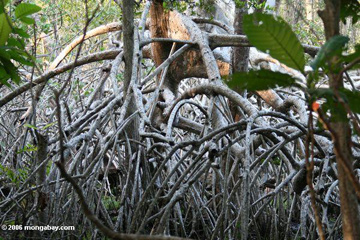Agriculture is primary cause of mangrove destruction
Agriculture is primary driver of mangrove destruction
mongabay.com
October 31, 2007
Agricultural expansion — not shrimp farming — is driving the rapid destruction of the world’s mangrove forests, reports a new study published in the Journal of Biogeography.
Analyzing more than 750 Landsat satellite images across Asia, Chandra Giri of Science Application International Corporation (SAIC) and colleagues found that 81 percent of mangrove deforestation from 1975 to 2005 was the result of agricultural encroachment. Aquaculture (12 percent) and urban development (2 percent) were secondary drivers of the destruction of these biologically important ecosystems.
 Mangrove forest clearing for aquaculture in Indonesia.
|
The research revealed that the tsunami-impacted regions of Indonesia, Malaysia, Thailand, Myanmar, Bangladesh, India, and Sri Lanka lost 12% of their mangrove forests from 1975 to 2005, well below the 25-50 percent loss for the rest of Asia. Overall Myanmar (Burma) had the highest mangrove deforestation rate (at one percent) between 1975 to 2005 while Sri Lanka has the lowest (0.1 percent). The study also reported that mangrove destruction peaked at 137,000 hectares annually during 1990-2000, increasing from 97,000 ha during 1975-1990 and declining to 14,000 hectares during 2000-2005.
Mangrove forests, which once covered more than 200,000 square kilometers of coastline, have been diminished by 35-86 percent in extent in locations around the world, according to the U.N. Food and Agriculture Organization, and are critically endangered or approaching extinction in 26 out of the 120 countries in which they are found. Further, mangrove forests are disappearing at a rate of 1-2 percent per year, a pace that surpasses the destruction of adjacent ecosystems, coral reefs and tropical rainforests. These losses, combined with increasing fragmentation of mangroves, reduces their viability and the quality of the services–including controlling coastal erosion, buffering against storm damage, and serving as a refuge for wildlife–they provide.
CITATION: C. Giri, Z. Zhu, L. L. Tieszen, A. Singh, S. Gillette, J. A. Kelmelis (2007). Mangrove forest distributions and dynamics (1975-2005) of the tsunami-affected region of Asia Journal of Biogeography (OnlineEarly Articles). doi:10.1111/j.1365-2699.2007.01806.x
Related articles
Mangroves more threatened than rainforests
(7/5/2007) Destruction of mangrove forests could leave the world deprived of their important ecological services by the end of a century, warns an international team of scientists writing in the July 6th issue of the journal Science.
Panama Canal port projects threaten mangroves
(3/6/2007) Port development and land speculation in Panama is turning some of the Caribbean’s most productive mangrove forests into landfill. The landfill would be used for container storage near the city of Colon, at the mouth of the Panama Canal. But local scientists say the transformation could have unintended environmental consequences.








